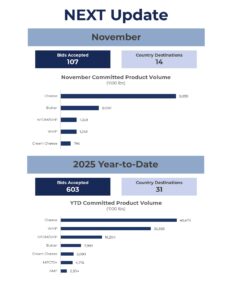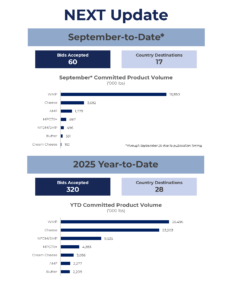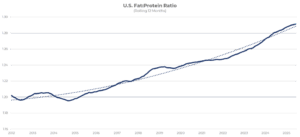- Advocated for dairy priorities in administration’s Reciprocal Trade Deals
- Secured the reintroduction and advancement of key common names bill
- Spurred federal investigation into global nonfat milk solids marketplace
- Expanded network of allied organizations
- Advanced key supply chain initiatives
NMPF has actively navigated the new administration’s proactive and unconventional trade approach to forge better global prospects for U.S. dairy exporters.
As the Trump administration’s trade negotiations unfold, NMPF Executive Vice Presidents Jaime Castaneda and Shawna Morris are serving as confidential private sector advisers to the U.S. Trade Representative and U.S. Department of Agriculture, offering guidance to ensure that U.S. dairy interests are represented and pursued across the globe.
To date, the United States announced trade frameworks with key dairy trading partners including South Korea, the European Union, the United Kingdom, Japan, Vietnam, the Philippines, and Indonesia. These frameworks vary in scope and detail and are designed to set the stage for more detailed negotiations to follow soon.
The frameworks with Indonesia, Vietnam and the Philippines are particularly promising for dairy exporters. It appears likely that all three countries will zero out tariffs on U.S. dairy exports, leveling the playing field with New Zealand and Australia, and in some cases the European Union too. Indonesia’s framework also addresses longstanding barriers that have made it difficult for American companies to compete in the market. This includes dairy facility registration approval improvements and steps that would help protect common name rights in Indonesia for products like “parmesan” and “feta.” Details on all announced trade details are forthcoming.
In addition to providing guidance as cleared advisors, NMPF worked hard in the months leading up to the negotiations to lay the groundwork for success. As the administration began to fill out its cabinet and agency positions, NMPF and the U.S. Dairy Export Council (USDEC) shared trade priorities with incoming USTR and USDA officials to improve the global competitive landscape for U.S. dairy exporters. NMPF President and CEO Gregg Doud testified before the House Ways & Means Trade Subcommittee, where he called for the U.S. government to pursue greater market access for U.S. products and enforce existing trade agreements.
Throughout its meetings and engagements with the Trump Administration, NMPF has stressed the need to preserve trade flows, while encouraging a tailored approach to tariffs that ensure fairness for U.S. farmers and workers.
NMPF remained active in multiple trade-related areas that went beyond negotiations, for example supporting the Apr. 1 reintroduction of the Safeguarding American Food and Export Trade Yields (SAFETY) Act and continuing additional efforts to proactively protect common food names for American cheesemakers. Originally introduced as the Safeguarding American Value-Added Exports (SAVE) Act in 2023, the SAFETY Act would direct the U.S. Department of Agriculture and U.S. Trade Representative to prioritize the protection of common names like “parmesan” in international trade negotiations.
As Congress and the administration prepare for next year’s critical U.S.-Mexico-Canada Agreement (USMCA) review process, NMPF is engaging with and supporting the U.S. Trade Representative’s office and other key stakeholders to ensure that they have the information needed to strengthen the agreement for U.S. dairy producers and exporters.
A particular issue that needs addressing is Canada’s dairy policies that incentivize dairy protein to be produced, then offloaded globally at artificially low prices — including by shifting tariff codes to evade USMCA export surcharges.
NMPF responded to this issue by pressuring the administration to address Canada’s persistent flouting of USMCA commitments, which led to a U.S. International Trade Commission (USITC) investigation launched May 20 into the export competitiveness of nonfat milk solids industries in the United States and other major suppliers. NMPF submitted written comments as part of that investigation outlining underhanded practices by Canada and other global suppliers that harm U.S. producers. NMPF’s Jaime Castaneda and Will Loux further elaborated on those points at a July 28 USITC hearing in the case.
NMPF has expanded its network of international allies, strengthening its ability to advocate for U.S. dairy worldwide. During a March 17-20 trip to Central America, Castaneda closed a memorandum of understanding (MOU) between NMPF, USDEC, and the Guatemalan Dairy Development Association (ASODEL). The agreement strengthens ties between the U.S. and Guatemalan dairy industries as they advocate for free and fair-trade policies and promote greater dairy consumption.
NMPF and USDEC signed an MOU May 1 with KADIN, the Indonesian Chamber of Commerce, strengthening ties between the U.S. and Indonesian dairy industries. This agreement builds on a flourishing partnership between the two countries, launched by the establishment of the U.S.-Indonesia Dairy Partnership Program. This collaboration is focused on creating and distributing technical educational materials designed to empower small-scale dairy producers in Indonesia to improve the quality and quantity of their milk production while touting the value of complementary U.S. dairy imports to meet the full needs of Indonesia’s expanding school milk program.
To ensure that U.S. dairy exporters can depend on timely and reliable shipping and rail transportation, NMPF is prioritizing supply chain improvements.
USTR on Feb. 21 proposed to impose fees on Chinese-built and -operated cargo ships as part of a larger investigation into Chinese maritime dominance. While this action was well-intentioned, NMPF and USDEC filed comments on March 24 to warn the agency that additional service fees would significantly increase costs for American exporters and diminish shipping options for U.S. products — both of which could lead to loss of global market access. USTR heard the industry pushback and modified the rule on June 12 rolled back the severity of the proposed fees. NMPF continues to urge the agency to re-evaluate the remaining fees to ensure U.S. dairy exporters do not face additional costs to export.



 By Will Loux,
By Will Loux, 






